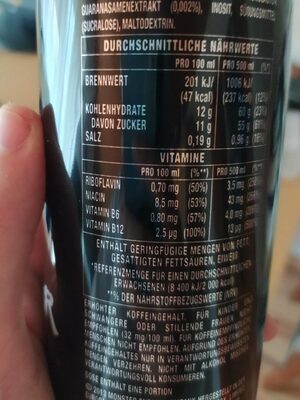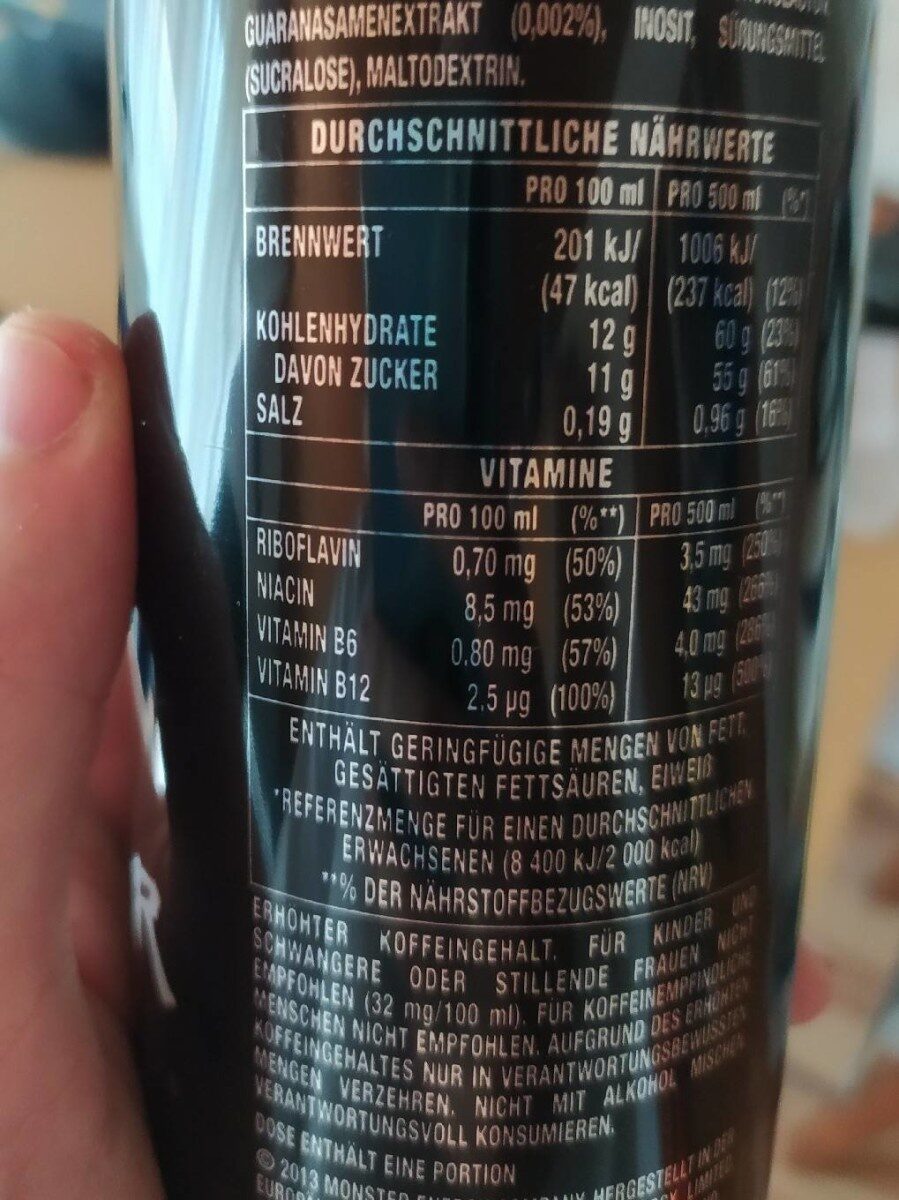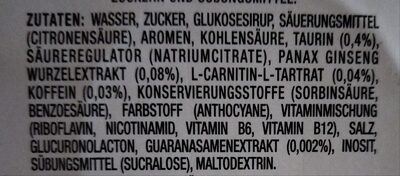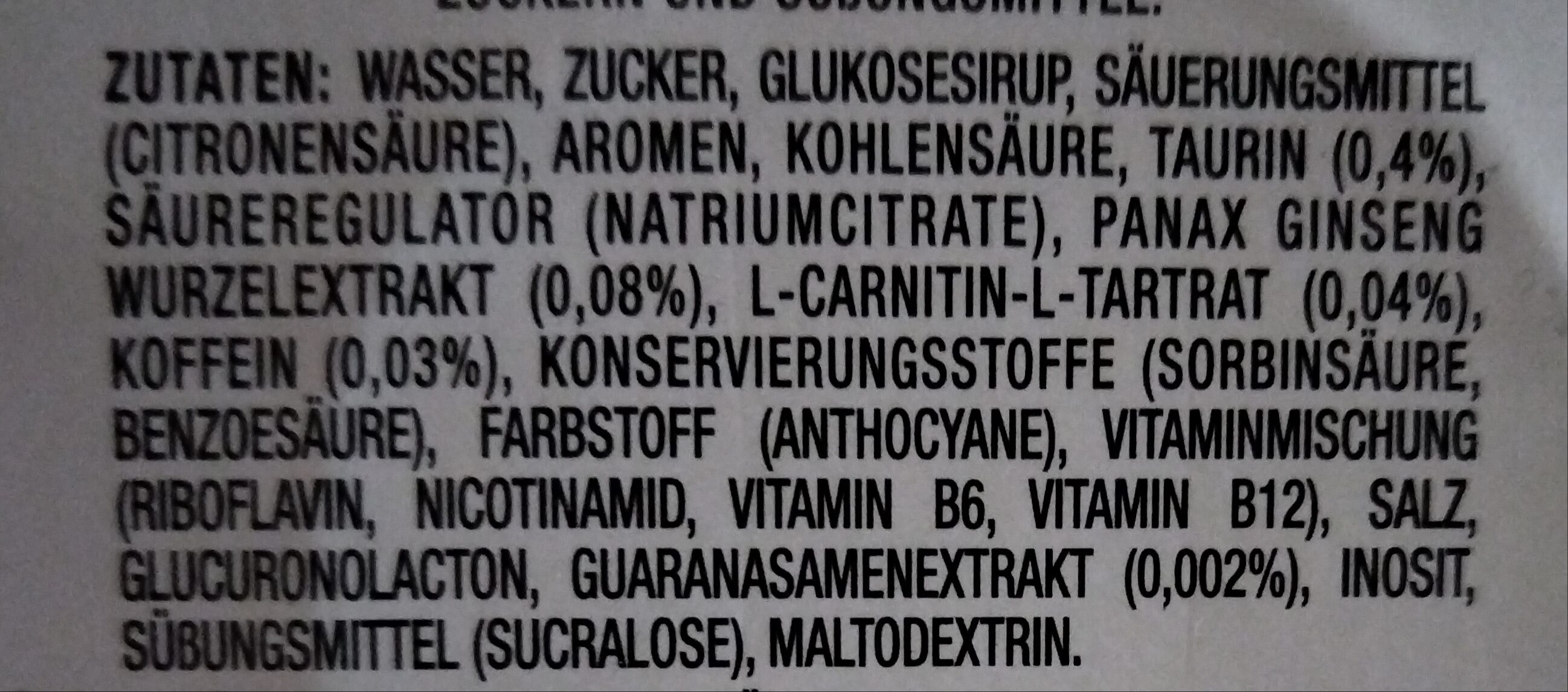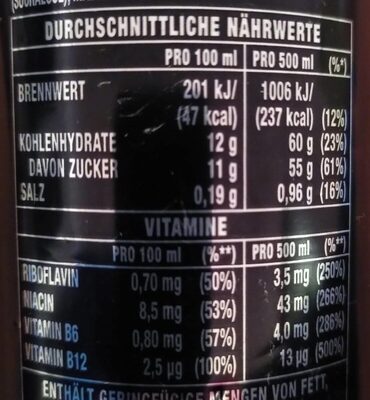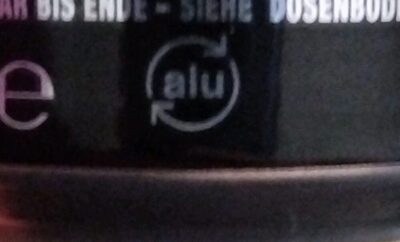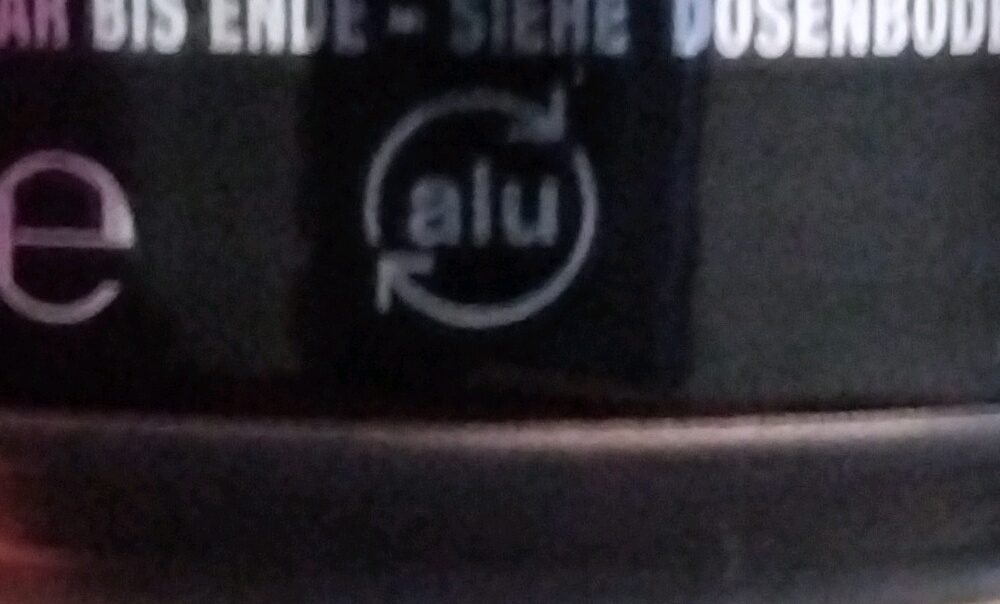Help us make food transparency the norm!
As a non-profit organization, we depend on your donations to continue informing consumers around the world about what they eat.
The food revolution starts with you!
Monster Energy - MonsterMonster Energy - 500ml
Monster Energy - MonsterMonster Energy - 500ml
Barcode: 5060335635228 (EAN / EAN-13)
Common name: Energy-Drink
Quantity: 500ml
Packaging:
Metal, Recyclable Metals, Aluminium, Can, de:Einwegpfand
Brands: MonsterMonster Energy, , Monster Energy
Categories: Beverages, Energy drinks, Energy drink with sugar, Sweetened beverages, Energydrink-mit-zucker, Getranke
Labels, certifications, awards: Vegetarian, Vegan, Made in the EU, Vegetarisch
Origin of ingredients: European Union, Ireland
Link to the product page on the official site of the producer: https://www.monsterenergy.com/de-de/ener...
Countries where sold: Germany, Deutschland
Matching with your preferences
Health
Ingredients
-
30 ingredients
German: WASSER, ZUCKER, GLUKOSESIRUP, SÄUERUNGSMITTEL (CITRONENSÄURE), AROMEN, KOHLENSÄURE, TAURIN (0,4%), SÄUREREGULATOR (NATRIUMCITRATE), PANAX GINSENG WURZELEXTRAKT (0,08%), L-CARNITIN-L-TARTRAT (0,04%), KOFFEIN (0,03%), KONSERVIERUNGSSTOFFE (SORBINSÄURE, BENZOESÄURE), FARBSTOFF (ANTHOCYANE), VITAMINMISCHUNG (RIBOFLAVIN, NICOTINAMID, VITAMIN B6, VITAMIN B12), SALZ, GLUCURONOLACTON, GUARANASAMENEXTRAKT (0,002%), INOSIT, SÜBUNGSMITTEL (SUCRALOSE), MALTODEXTRIN.
Food processing
-
Ultra processed foods
Elements that indicate the product is in the 4 - Ultra processed food and drink products group:
- Additive: E101 - Riboflavin
- Additive: E163 - Anthocyanins
- Additive: E290 - Carbon dioxide
- Additive: E955 - Sucralose
- Ingredient: Colour
- Ingredient: Flavouring
- Ingredient: Glucose
- Ingredient: Glucose syrup
- Ingredient: Maltodextrin
Food products are classified into 4 groups according to their degree of processing:
- Unprocessed or minimally processed foods
- Processed culinary ingredients
- Processed foods
- Ultra processed foods
The determination of the group is based on the category of the product and on the ingredients it contains.
Additives
-
E101 - Riboflavin
Riboflavin: Riboflavin, also known as vitamin B2, is a vitamin found in food and used as a dietary supplement. Food sources include eggs, green vegetables, milk and other dairy product, meat, mushrooms, and almonds. Some countries require its addition to grains. As a supplement it is used to prevent and treat riboflavin deficiency and prevent migraines. It may be given by mouth or injection.It is nearly always well tolerated. Normal doses are safe during pregnancy. Riboflavin is in the vitamin B group. It is required by the body for cellular respiration.Riboflavin was discovered in 1920, isolated in 1933, and first made in 1935. It is on the World Health Organization's List of Essential Medicines, the most effective and safe medicines needed in a health system. Riboflavin is available as a generic medication and over the counter. In the United States a month of supplements costs less than 25 USD.Source: Wikipedia
-
E101i - Riboflavin
Riboflavin: Riboflavin, also known as vitamin B2, is a vitamin found in food and used as a dietary supplement. Food sources include eggs, green vegetables, milk and other dairy product, meat, mushrooms, and almonds. Some countries require its addition to grains. As a supplement it is used to prevent and treat riboflavin deficiency and prevent migraines. It may be given by mouth or injection.It is nearly always well tolerated. Normal doses are safe during pregnancy. Riboflavin is in the vitamin B group. It is required by the body for cellular respiration.Riboflavin was discovered in 1920, isolated in 1933, and first made in 1935. It is on the World Health Organization's List of Essential Medicines, the most effective and safe medicines needed in a health system. Riboflavin is available as a generic medication and over the counter. In the United States a month of supplements costs less than 25 USD.Source: Wikipedia
-
E163 - Anthocyanins
Anthocyanin: Anthocyanins -also anthocyans; from Greek: ἄνθος -anthos- "flower" and κυάνεος/κυανοῦς kyaneos/kyanous "dark blue"- are water-soluble vacuolar pigments that, depending on their pH, may appear red, purple, or blue. Food plants rich in anthocyanins include the blueberry, raspberry, black rice, and black soybean, among many others that are red, blue, purple, or black. Some of the colors of autumn leaves are derived from anthocyanins.Anthocyanins belong to a parent class of molecules called flavonoids synthesized via the phenylpropanoid pathway. They occur in all tissues of higher plants, including leaves, stems, roots, flowers, and fruits. Anthocyanins are derived from anthocyanidins by adding sugars. They are odorless and moderately astringent. Although approved to color foods and beverages in the European Union, anthocyanins are not approved for use as a food additive because they have not been verified as safe when used as food or supplement ingredients. There is no conclusive evidence anthocyanins have any effect on human biology or diseases.Source: Wikipedia
-
E200 - Sorbic acid
Sorbic acid: Sorbic acid, or 2‚4-hexadienoic acid, is a natural organic compound used as a food preservative. It has the chemical formula CH3-CH-4CO2H. It is a colourless solid that is slightly soluble in water and sublimes readily. It was first isolated from the unripe berries of the Sorbus aucuparia -rowan tree-, hence its name.Source: Wikipedia
-
E210 - Benzoic acid
Benzoic acid: Benzoic acid , C7H6O2 -or C6H5COOH-, is a colorless crystalline solid and a simple aromatic carboxylic acid. The name is derived from gum benzoin, which was for a long time its only known source. Benzoic acid occurs naturally in many plants and serves as an intermediate in the biosynthesis of many secondary metabolites. Salts of benzoic acid are used as food preservatives and benzoic acid is an important precursor for the industrial synthesis of many other organic substances. The salts and esters of benzoic acid are known as benzoates .Source: Wikipedia
-
E290 - Carbon dioxide
Carbon dioxide: Carbon dioxide -chemical formula CO2- is a colorless gas with a density about 60% higher than that of dry air. Carbon dioxide consists of a carbon atom covalently double bonded to two oxygen atoms. It occurs naturally in Earth's atmosphere as a trace gas. The current concentration is about 0.04% -410 ppm- by volume, having risen from pre-industrial levels of 280 ppm. Natural sources include volcanoes, hot springs and geysers, and it is freed from carbonate rocks by dissolution in water and acids. Because carbon dioxide is soluble in water, it occurs naturally in groundwater, rivers and lakes, ice caps, glaciers and seawater. It is present in deposits of petroleum and natural gas. Carbon dioxide is odorless at normally encountered concentrations, however, at high concentrations, it has a sharp and acidic odor.As the source of available carbon in the carbon cycle, atmospheric carbon dioxide is the primary carbon source for life on Earth and its concentration in Earth's pre-industrial atmosphere since late in the Precambrian has been regulated by photosynthetic organisms and geological phenomena. Plants, algae and cyanobacteria use light energy to photosynthesize carbohydrate from carbon dioxide and water, with oxygen produced as a waste product.CO2 is produced by all aerobic organisms when they metabolize carbohydrates and lipids to produce energy by respiration. It is returned to water via the gills of fish and to the air via the lungs of air-breathing land animals, including humans. Carbon dioxide is produced during the processes of decay of organic materials and the fermentation of sugars in bread, beer and wine making. It is produced by combustion of wood and other organic materials and fossil fuels such as coal, peat, petroleum and natural gas. It is an unwanted byproduct in many large scale oxidation processes, for example, in the production of acrylic acid -over 5 million tons/year-.It is a versatile industrial material, used, for example, as an inert gas in welding and fire extinguishers, as a pressurizing gas in air guns and oil recovery, as a chemical feedstock and as a supercritical fluid solvent in decaffeination of coffee and supercritical drying. It is added to drinking water and carbonated beverages including beer and sparkling wine to add effervescence. The frozen solid form of CO2, known as dry ice is used as a refrigerant and as an abrasive in dry-ice blasting. Carbon dioxide is the most significant long-lived greenhouse gas in Earth's atmosphere. Since the Industrial Revolution anthropogenic emissions – primarily from use of fossil fuels and deforestation – have rapidly increased its concentration in the atmosphere, leading to global warming. Carbon dioxide also causes ocean acidification because it dissolves in water to form carbonic acid.Source: Wikipedia
-
E330 - Citric acid
Citric acid is a natural organic acid found in citrus fruits such as lemons, oranges, and limes.
It is widely used in the food industry as a flavor enhancer, acidulant, and preservative due to its tart and refreshing taste.
Citric acid is safe for consumption when used in moderation and is considered a generally recognized as safe (GRAS) food additive by regulatory agencies worldwide.
-
E331 - Sodium citrates
Sodium citrate: Sodium citrate may refer to any of the sodium salts of citrate -though most commonly the third-: Monosodium citrate Disodium citrate Trisodium citrateThe three forms of the salt are collectively known by the E number E331. Sodium citrates are used as acidity regulators in food and drinks, and also as emulsifiers for oils. They enable cheeses to melt without becoming greasy.Source: Wikipedia
-
E955 - Sucralose
Sucralose: Sucralose is an artificial sweetener and sugar substitute. The majority of ingested sucralose is not broken down by the body, so it is noncaloric. In the European Union, it is also known under the E number E955. It is produced by chlorination of sucrose. Sucralose is about 320 to 1‚000 times sweeter than sucrose, three times as sweet as both aspartame and acesulfame potassium, and twice as sweet as sodium saccharin. Evidence of benefit is lacking for long-term weight loss with some data supporting weight gain and heart disease risks.It is stable under heat and over a broad range of pH conditions. Therefore, it can be used in baking or in products that require a long shelf life. The commercial success of sucralose-based products stems from its favorable comparison to other low-calorie sweeteners in terms of taste, stability, and safety. Common brand names of sucralose-based sweeteners are Splenda, Zerocal, Sukrana, SucraPlus, Candys, Cukren, and Nevella. Canderel Yellow also contains sucralose, but the original Canderel and Green Canderel do not.Source: Wikipedia
Ingredients analysis
-
Palm oil free
No ingredients containing palm oil detected
Unrecognized ingredients: de:sübungsmittelSome ingredients could not be recognized.
We need your help!
You can help us recognize more ingredients and better analyze the list of ingredients for this product and others:
- Edit this product page to correct spelling mistakes in the ingredients list, and/or to remove ingredients in other languages and sentences that are not related to the ingredients.
- Add new entries, synonyms or translations to our multilingual lists of ingredients, ingredient processing methods, and labels.
If you would like to help, join the #ingredients channel on our Slack discussion space and/or learn about ingredients analysis on our wiki. Thank you!
-
Vegan
No non-vegan ingredients
Unrecognized ingredients: Vitamin b12, Glucuronolactone, de:sübungsmittelSome ingredients could not be recognized.
We need your help!
You can help us recognize more ingredients and better analyze the list of ingredients for this product and others:
- Edit this product page to correct spelling mistakes in the ingredients list, and/or to remove ingredients in other languages and sentences that are not related to the ingredients.
- Add new entries, synonyms or translations to our multilingual lists of ingredients, ingredient processing methods, and labels.
If you would like to help, join the #ingredients channel on our Slack discussion space and/or learn about ingredients analysis on our wiki. Thank you!
-
Vegetarian
No non-vegetarian ingredients detected
Unrecognized ingredients: Vitamin b12, Glucuronolactone, de:sübungsmittelSome ingredients could not be recognized.
We need your help!
You can help us recognize more ingredients and better analyze the list of ingredients for this product and others:
- Edit this product page to correct spelling mistakes in the ingredients list, and/or to remove ingredients in other languages and sentences that are not related to the ingredients.
- Add new entries, synonyms or translations to our multilingual lists of ingredients, ingredient processing methods, and labels.
If you would like to help, join the #ingredients channel on our Slack discussion space and/or learn about ingredients analysis on our wiki. Thank you!
-
Details of the analysis of the ingredients
We need your help!
Some ingredients could not be recognized.
We need your help!
You can help us recognize more ingredients and better analyze the list of ingredients for this product and others:
- Edit this product page to correct spelling mistakes in the ingredients list, and/or to remove ingredients in other languages and sentences that are not related to the ingredients.
- Add new entries, synonyms or translations to our multilingual lists of ingredients, ingredient processing methods, and labels.
If you would like to help, join the #ingredients channel on our Slack discussion space and/or learn about ingredients analysis on our wiki. Thank you!
de: WASSER, ZUCKER, GLUKOSESIRUP, SÄUERUNGSMITTEL (CITRONENSÄURE), AROMEN, KOHLENSÄURE, TAURIN 0.4%, SÄUREREGULATOR (NATRIUMCITRATE), PANAX GINSENG WURZELEXTRAKT 0.08%, L-CARNITIN-L-TARTRAT 0.04%, KOFFEIN 0.03%, KONSERVIERUNGSSTOFFE (SORBINSÄURE, BENZOESÄURE), FARBSTOFF (ANTHOCYANE), VITAMINMISCHUNG (RIBOFLAVIN, NICOTINAMID, VITAMIN B6, VITAMIN B12), SALZ, GLUCURONOLACTON, GUARANASAMENEXTRAKT 0.002%, INOSIT, SÜBUNGSMITTEL (SUCRALOSE), MALTODEXTRIN- WASSER -> en:water - vegan: yes - vegetarian: yes - ciqual_food_code: 18066 - percent_min: 55.892 - percent_max: 97.358
- ZUCKER -> en:sugar - vegan: yes - vegetarian: yes - ciqual_proxy_food_code: 31016 - percent_min: 0.4 - percent_max: 11
- GLUKOSESIRUP -> en:glucose-syrup - vegan: yes - vegetarian: yes - ciqual_proxy_food_code: 31016 - percent_min: 0.4 - percent_max: 11
- SÄUERUNGSMITTEL -> en:acid - percent_min: 0.4 - percent_max: 11
- CITRONENSÄURE -> en:e330 - vegan: yes - vegetarian: yes - percent_min: 0.4 - percent_max: 11
- AROMEN -> en:flavouring - vegan: maybe - vegetarian: maybe - percent_min: 0.4 - percent_max: 5
- KOHLENSÄURE -> en:e290 - vegan: yes - vegetarian: yes - percent_min: 0.4 - percent_max: 5
- TAURIN -> en:taurine - vegan: maybe - vegetarian: maybe - percent_min: 0.4 - percent: 0.4 - percent_max: 0.4
- SÄUREREGULATOR -> en:acidity-regulator - percent_min: 0.08 - percent_max: 0.4
- NATRIUMCITRATE -> en:e331 - vegan: yes - vegetarian: yes - percent_min: 0 - percent_max: 0.4
- PANAX GINSENG WURZELEXTRAKT -> en:panax-ginseng-root-extract - vegan: yes - vegetarian: yes - percent_min: 0.08 - percent: 0.08 - percent_max: 0.08
- L-CARNITIN-L-TARTRAT -> en:l-carnitine-l-tartrate - vegan: maybe - vegetarian: maybe - percent_min: 0.04 - percent: 0.04 - percent_max: 0.04
- KOFFEIN -> en:caffeine - vegan: yes - vegetarian: yes - percent_min: 0.03 - percent: 0.03 - percent_max: 0.03
- KONSERVIERUNGSSTOFFE -> en:preservative - percent_min: 0.002 - percent_max: 0.03
- SORBINSÄURE -> en:e200 - vegan: yes - vegetarian: yes - percent_min: 0 - percent_max: 0.03
- BENZOESÄURE -> en:e210 - vegan: yes - vegetarian: yes - percent_min: 0 - percent_max: 0.03
- FARBSTOFF -> en:colour - percent_min: 0.002 - percent_max: 0.03
- ANTHOCYANE -> en:e163 - vegan: yes - vegetarian: yes - percent_min: 0 - percent_max: 0.03
- VITAMINMISCHUNG -> en:vitamins - vegan: yes - vegetarian: yes - percent_min: 0.002 - percent_max: 0.03
- RIBOFLAVIN -> en:e101 - vegan: maybe - vegetarian: yes - percent_min: 0 - percent_max: 0.03
- NICOTINAMID -> en:e375 - vegan: maybe - vegetarian: maybe - percent_min: 0 - percent_max: 0.03
- VITAMIN B6 -> en:vitamin-b6 - vegan: yes - vegetarian: yes - percent_min: 0 - percent_max: 0.03
- VITAMIN B12 -> en:vitamin-b12 - percent_min: 0 - percent_max: 0.03
- SALZ -> en:salt - vegan: yes - vegetarian: yes - ciqual_food_code: 11058 - percent_min: 0.002 - percent_max: 0.03
- GLUCURONOLACTON -> en:glucuronolactone - percent_min: 0.002 - percent_max: 0.03
- GUARANASAMENEXTRAKT -> en:guarana-seed-extract - vegan: yes - vegetarian: yes - percent_min: 0.002 - percent: 0.002 - percent_max: 0.002
- INOSIT -> en:inositol - vegan: yes - vegetarian: yes - percent_min: 0 - percent_max: 0.002
- SÜBUNGSMITTEL -> de:sübungsmittel - percent_min: 0 - percent_max: 0.002
- SUCRALOSE -> en:e955 - vegan: yes - vegetarian: yes - percent_min: 0 - percent_max: 0.002
- MALTODEXTRIN -> en:maltodextrin - vegan: yes - vegetarian: yes - percent_min: 0 - percent_max: 0.002
Nutrition
-
Bad nutritional quality
⚠ ️Warning: the amount of fruits, vegetables and nuts is not specified on the label, it was estimated from the list of ingredients: 0This product is considered a beverage for the calculation of the Nutri-Score.
Positive points: 0
- Proteins: 0 / 5 (value: 0, rounded value: 0)
- Fiber: 0 / 5 (value: 0, rounded value: 0)
- Fruits, vegetables, nuts, and colza/walnut/olive oils: 0 / 10 (value: 0, rounded value: 0)
Negative points: 15
- Energy: 7 / 10 (value: 201, rounded value: 201)
- Sugars: 8 / 10 (value: 11, rounded value: 11)
- Saturated fat: 0 / 10 (value: 0, rounded value: 0)
- Sodium: 0 / 10 (value: 76, rounded value: 76)
The points for proteins are not counted because the negative points are greater or equal to 11.
Nutritional score: (15 - 0)
Nutri-Score:
-
Nutrient levels
-
Fat in low quantity (0%)
What you need to know- A high consumption of fat, especially saturated fats, can raise cholesterol, which increases the risk of heart diseases.
Recommendation: Limit the consumption of fat and saturated fat- Choose products with lower fat and saturated fat content.
-
Saturated fat in low quantity (0%)
What you need to know- A high consumption of fat, especially saturated fats, can raise cholesterol, which increases the risk of heart diseases.
Recommendation: Limit the consumption of fat and saturated fat- Choose products with lower fat and saturated fat content.
-
Sugars in high quantity (11%)
What you need to know- A high consumption of sugar can cause weight gain and tooth decay. It also augments the risk of type 2 diabetes and cardio-vascular diseases.
Recommendation: Limit the consumption of sugar and sugary drinks- Sugary drinks (such as sodas, fruit beverages, and fruit juices and nectars) should be limited as much as possible (no more than 1 glass a day).
- Choose products with lower sugar content and reduce the consumption of products with added sugars.
-
Salt in moderate quantity (0.19%)
What you need to know- A high consumption of salt (or sodium) can cause raised blood pressure, which can increase the risk of heart disease and stroke.
- Many people who have high blood pressure do not know it, as there are often no symptoms.
- Most people consume too much salt (on average 9 to 12 grams per day), around twice the recommended maximum level of intake.
Recommendation: Limit the consumption of salt and salted food- Reduce the quantity of salt used when cooking, and don't salt again at the table.
- Limit the consumption of salty snacks and choose products with lower salt content.
-
-
Nutrition facts
Nutrition facts As sold
for 100 g / 100 mlAs sold
per serving (500ml)Compared to: Energy drink with sugar Energy 201 kj
(47 kcal)1,000 kj
(235 kcal)+15% Fat 0 g 0 g -100% Saturated fat 0 g 0 g -100% Carbohydrates 12 g 60 g +21% Sugars 11 g 55 g +18% Fiber 0 g 0 g -100% Proteins 0 g 0 g -100% Salt 0.19 g 0.95 g +93% Vitamin B2 (Riboflavin) 0.7 mg 3.5 mg +14% Vitamin B3/PP (Niacin) 8.5 mg 42.5 mg +33% Vitamin B6 (Pyridoxin) 0.8 mg 4 mg +15% Vitamin B12 (cobalamin) 2.5 µg 12.5 µg -82% Fruits‚ vegetables‚ nuts and rapeseed‚ walnut and olive oils (estimate from ingredients list analysis) 0 % 0 %
Environment
-
Eco-Score not yet applicable
Not yet applicable for the category: Energy drinks
The Eco-Score is not yet applicable for this category, but we are working on adding support for it.
Packaging
-
Packaging with a low impact
-
Packaging parts
Can (Aluminium)
-
Packaging materials
Material % Packaging weight Packaging weight per 100 g of product Metal
-
Transportation
-
Origins of ingredients
Origins of ingredients with a high impact
Origin of the product and/or its ingredients % of ingredients Impact European Union 50 %High Ireland 50 %Medium
Report a problem
-
Incomplete or incorrect information?
Category, labels, ingredients, allergens, nutritional information, photos etc.
If the information does not match the information on the packaging, please complete or correct it. Open Food Facts is a collaborative database, and every contribution is useful for all.
Data sources
Product added on by kiliweb
Last edit of product page on by helmutbergheim.
Product page also edited by alexreactionsmasher, bombine, camocarl81, cjk, dn177, halal-app-chakib, j-r, jblond, kraizy, manuki, mezzocannone, openfoodfacts-contributors, packbot, prepperapp, scanbot, sebleouf, standardanalysis, toph28, yabr, yuka.UWJJN05MVllqTUlsdS9BVDF5cjY4TnRXeVpDSVRVMm9JTU5JSUE9PQ, yuka.sY2b0xO6T85zoF3NwEKvlh1eateOj2_ECQbRuVSEwPu2CsbrTPpSzoWrE6o, yuka.sY2b0xO6T85zoF3NwEKvlk1JAsfsqw7pCxjTx23X5PLSEMbJToF704fmN6g, yuka.sY2b0xO6T85zoF3NwEKvlkVLb9eFkm3EDSXjnVO6m8-EPp22P_pDy5L2I6s, yuka.sY2b0xO6T85zoF3NwEKvlkofAor1kALBDDL6u1CBxIqsNKXGaNBM_oP9Iag, yuka.sY2b0xO6T85zoF3NwEKvll52bNGPhQ78Mhjkn2-tysiVLZz5TPRYvanEEqo, yuka.sY2b0xO6T85zoF3NwEKvllR5DP7Qsyr5Pk3SwVWS-oqOd5i1TcFt64jla6s, yuka.sY2b0xO6T85zoF3NwEKvllweTNaGnxHYaEDnolDS7daIPqzOc4wq76HUaKo, yuka.sY2b0xO6T85zoF3NwEKvlnJsaMrQ-T2fNTjtnUKa5NafMa61bfN58qHeI6g, yuka.sY2b0xO6T85zoF3NwEKvlnZ8SN3nvTzmDRDQwnS7wYqDCJ7Vbeoj5bDVPas.
